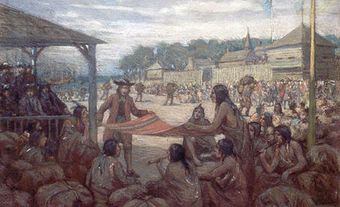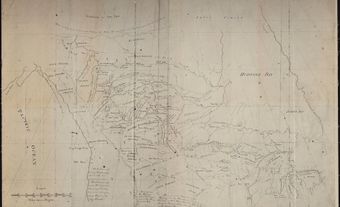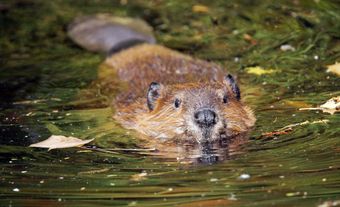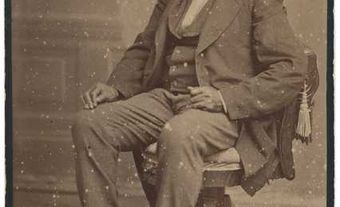During the fur trade in Canada, items of European manufacture (historically referred to in the literature as Indian trade goods) were traded with Indigenous peoples for furs. These items include, for example, metal objects, weapons and glass beads. (See also Trade Silver.)
In various ways, however, cultural exchanges went both ways. Some Europeans, namely the voyageurs, adopted various Indigenous technologies and clothing during the fur trade, including
the use of moccasins, buckskin pants and hats, and snowshoes.
Early Contact
For the initial stages of culture contact, Europeans traded, in exchange for furs from Indigenous peoples, goods with stray bits of metal (e.g., an old iron axe or knife, a handful of nails), pieces of rope and used clothing. During this period, most of the trade in furs was carried out by fishermen who had gone ashore to dry their catches. Although the volume of trade was small, the profits were relatively large. This is because items of little value to a European could be traded for furs that came at an excellent price in the home market.
Fur Trade Goods: Iron Axes to Glass Beads and More
During the 16th century, however, the fur trade gradually developed into a separate branch of commerce. Ships solely engaged in trade were sent to the eastern seaboard with cargoes of manufactured goods. At this stage, decisions had to be made about the type of trade goods that would be in greatest demand and would produce the most furs at the best prices.
From the beginning, one of the most important items of trade was the iron axe. Axes were imported into French Canada in such numbers that they were literally "harvested" in many parts of southern Ontario, forming the first cash crop of the settlers who were breaking the land. The axes were formed by bending a short length of bar iron around a mandrel (a cylindrical rod) to form a wedge-shaped eye, then welding the ends of the bar together and hammering it into a long heavy blade. A thin piece of steel was usually set into the blade so that the tool would take and hold a sharper edge.
These early French felling axes have been found throughout eastern Canada and scattered across New York and Ohio and down the Mississippi drainage; however, their highest concentration has been in southern Ontario and western New York, the homeland of the Iroquoian-speaking peoples.
Although generations of children were raised with the impression that the old trade axes were weapons, archaeological evidence suggests that they were used, primarily by women, for breaking up limbs and brush for firewood. They would, of course, have been used for many other purposes as well.
While the heavy French felling axe was quite acceptable to the typically sedentary Iroquoian peoples, it was much too cumbersome for the hunters and gatherers of the northern forests. Therefore, the French introduced the lighter, more slender Biscay axe. This axe was probably introduced into the trade towards the end of the 17th century, at about the same time the Hudson's Bay Company (HBC) was establishing trading posts on James Bay.
The English also found their axes too cumbersome for the Algonquian-speaking peoples with whom they traded and therefore introduced a lighter, hatchet-like tool. The minor stylistic differences between axe types were probably not significant to the Indigenous peoples. But to archaeologists and historians, such minor differences are of primary importance. The distribution of the different types across an area allows reconstruction of the trade routes that stretched out from the various commercial centres.
In addition, if the dates at which different styles were introduced into the trade are determined, the information can be used in dating archaeological sites. For example, the earliest flintlock musket that the HBC traded into James Bay had a flat cock and lock plate; however, in 1682 the Oakes pattern, with rounded outer surfaces on the cock and lock plate, was introduced. These rounded surfaces remained characteristic of the North-West gun throughout its history. Any archaeological site which produces the Oakes-pattern musket must postdate 1682.
Styles in trade goods changed over time. Although few such changes can be precisely dated, many are known with reasonable precision. For example, a collection of kaolin (clay) pipes can usually be dated to within a 10-year period, as can a collection of glass bottles. Glass beads and brass kettles are much more difficult to date, although some clues are available. For example, larger star beads are associated only with early French sites; small brass kettles with vertical sides seem to appear only on very late sites that were supplied by the HBC.
Reasons for Trading
Indigenous peoples adopted items of European manufacture because the technology often was convenient. For example, flintlock muskets, iron axes and knives and brass kettles were considered more efficient than the bows and arrows, stone tools and birchbark baskets they replaced.
Trade goods, however, were not limited to practical objects. A pipe of tobacco may not have made a trapper more efficient, but it did make him more serene. Similarly, Indigenous women could have tied back their hair with strips of skin, as had their ancestors for countless generations, but they found a brightly coloured ribbon offered by the Europeans attractive.
For Europeans, their purpose for trading was to gain valuable furs. During periods of contact, some Europeans, like the voyageurs, adopted Indigenous technologies and clothing as well. This includes, for example, moccasins, types of buckskin clothing and snowshoes.
French and English Rivalry
The volume of goods imported during the early fur trade period was impressive. For example, in 1684 the HBC shipped 300 flintlock muskets, 2,000 iron axes, 2,160 kaolin (clay) tobacco pipes, 3,000 jackknives and 5,000 butcher knives to its Albany post. During this period, the fur trade was dominated by those historic rivals, the French and English. The French led the way westward, following the ancient canoe routes of the Indigenous peoples. (See also Fur Trade Routes.)
Even after the conquest of New France, the commercial rivalry continued, with the Montreal traders pushing farther and farther west. At the height of their power, they were following a well-established "Voyageurs' Highway" that stretched from Montreal on the St. Lawrence to Fort Chipewyan on Lake Athabasca. The trade goods they carried, the muskets, kettles, beads, pipes, woolen clothing, blankets, etc., were the currency of the fur trade, a trade that opened up half a continent and gave Canada its basic configuration.

 Share on Facebook
Share on Facebook Share on X
Share on X Share by Email
Share by Email Share on Google Classroom
Share on Google Classroom









